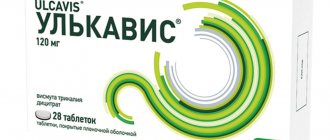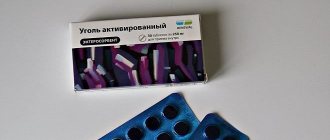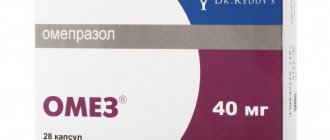Omeprazole for heartburn is the drug of choice in the treatment of diseases of the digestive system. Heartburn is a classic symptom of diseases such as gastritis, ulcers, GERD (gastroesophageal reflux disease).
The drug affects the efficiency of parietal cells in the stomach (these cells are responsible for the synthesis of hydrochloric acid, the main component of gastric juice). It blocks the work of parietal cells after the first use by only 40–50%, therefore it is weakly effective in the first days of use, and requires long-term use to achieve optimal drug concentration in the patient’s body.
Omeprazole is a drug for symptomatic therapy; it relieves discomfort in the epigastric region, helping to eliminate burning chest pain, tingling, and burning.
The drug is used only after consultation with a doctor and an accurate diagnosis. Consultation with a gastroenterologist and therapist is indicated; in children, a pediatrician.
Omeprazole is an effective remedy for heartburn
How to take Omeprazole for heartburn
Release form: white capsules, hard, rounded at the ends. Analogs are available in powder form (used more often in children due to the inability to swallow the capsule). Not available in tablet form.
Dosage
Doses and conditions of use in adults for various diseases:
| Indications | Application |
| Treatment of duodenal ulcer (acute phase) | 20 mg (1 capsule) per day for 2 weeks. In case of resistance, 40 mg per day (2 tablets) is prescribed for 4 weeks. |
| Treatment of gastric ulcer in the acute phase | 20 mg (1 capsule) per day. Course 4 weeks. |
| Prevention of exacerbations of gastric and duodenal ulcers | 20 mg (1 capsule) per day for 2 weeks. |
| As a component in the treatment of Helicobacter pylori infection (included in the regimen along with two antibiotics) | 20 mg (1 capsule) per day for 2 weeks. |
| Treatment of ulcers caused by long-term use of non-steroidal anti-inflammatory drugs | 20 mg (1 capsule) per day for 2 weeks. In this case, there are patients at risk of developing ulcers (60 years and older, history of gastrointestinal bleeding). Such patients are prescribed 20 mg (1 capsule) per day for prophylaxis for 2 weeks. |
| Treatment of reflux esophagitis | 20 mg (1 capsule) per day for 4 weeks. In severe conditions, the dose is increased to 4 mg (2 capsules). You must take the drug for 8 weeks. |
| Treatment of gastroesophageal reflux disease | 20 mg (1 capsule) per day for 4 weeks |
| Treatment of Zollinger–Ellison syndrome | Starting dose: 60 mg (3 capsules) per day for 2 weeks. As treatment progresses, a higher dose is prescribed (up to 120 mg per day) |
Doses and conditions of use in children:
| Indications | Application |
| Treatment of reflux esophagitis, usually resistant to other drugs | Children over two years old - body weight more than 20 kg - are prescribed 20 mg (1 capsule) per day for 4 weeks |
| Treatment of duodenal ulcer in children and adolescents | With a body weight of 15–30 kg, Omeprazole is taken 20 mg (1 capsule) per day. With a body weight of more than 30 kg, it is permissible to increase the concentration of the drug to 40 mg (2 capsules) per day. The drug course of therapy is 7–14 days. |
Rules of application
Take the entire capsule 30 minutes before meals. When the capsule is separated, the quality of treatment sharply decreases (the drug loses bioavailability and effectiveness by 30%). If children need to take it, it is better to resort to the use of analogues (powders, injections).
Omeprazole as an over-the-counter treatment for heartburn
Heartburn is defined as “a burning sensation and pain in the chest and/or epigastric region, spreading from bottom to top, often associated with a feeling of fullness in the epigastrium, occurring in various body positions, on an empty stomach or after eating food, drinks, or smoking.”
Heartburn can be a manifestation of a large number of pathological conditions. The most common among them are gastroesophageal reflux disease (GERD), peptic ulcer, non-ulcer (functional) dyspepsia, gastropathy associated with taking non-steroidal anti-inflammatory drugs.
Heartburn is common in the population both in Russia and in other countries of the world. According to statistics, 10–20% of the population of several European countries experience heartburn from one to several times a day [1, 2]. In the United States, 28% of residents report heartburn. It is known that the frequency of heartburn largely depends on the nature of the diet. In the USA, compared to Europe, the so-called “fast food” occupies a fairly large part of the population’s nutritional structure. Fast food restaurants and cafes usually offer dishes with flavor enhancers, large amounts of refractory fats and other components that do not meet the requirements of a healthy dietary diet [3]. Epidemiological studies of the incidence of heartburn have also been conducted in the Russian Federation. Thus, based on a survey of 20 thousand patients who visited the clinic for a variety of reasons, it was found that in people under 60 years of age, heartburn is a common cause of decreased quality of life (refusing favorite drinks, limiting physical activity and even sleep disturbances). In people over 60 years of age, heartburn was reported by 62% of study participants [4]. An analysis of the prevalence of heartburn in the national epidemiological study of the adult population ARIADNA (Analysis of the prevalence of heartburn: a national epidemiological study of the adult urban population), conducted in 11 cities of Russia, revealed that 22.7% of respondents had frequent heartburn (more than 2-3 times a week) [ 5]. According to the MEGRE study (Multicenter study “Epidemiology of gastroesophageal reflux disease in Russia”), heartburn occurred occasionally in 47.5% of adults [6]. It was noted that in young people called up to serve in the army, with a sharp change in the nature of food, increased workload, and stressful situations, the risk of heartburn is 24.8%. Moreover, in almost 60% of cases, there are no signs of esophagitis during fibrogastroduodenoscopy [7].
In most cases, heartburn occurs due to the reflux of acidic stomach contents into the esophagus. The basis of normal and pathological reflux is transient relaxation of the lower esophageal sphincter. In healthy individuals, gravity and peristalsis quickly remove the reflux substrate, and ingested saliva neutralizes the remaining esophageal adhering acid. Heartburn occurs when these mechanisms and/or endogenous mucosal defense mechanisms are disrupted. Thus, frequent inadequate transient relaxations of the lower esophageal sphincter increase the time of contact of the mucous membrane with hydrochloric acid. It has been shown that from 53% to 71% of heartburn sufferers have endoscopically normal esophageal mucosa.
Much attention has recently been paid to functional heartburn, the diagnostic criteria of which are chest discomfort or the occurrence of pain at least 1 day a week. Patients with this type of heartburn do not show the classic signs of GERD based on 24-hour pH testing. There is no doubt that frequent heartburn can signal the presence of a serious pathological process, be a manifestation of various (including erosive) forms of GERD, peptic ulcers and a number of other diseases and be a reason to consult a doctor. Using various diagnostic measures, the doctor must determine whether heartburn is a consequence of functional disorders or whether it is a symptom of organic damage to the upper parts of the digestive organs.
Symptoms that, in addition to heartburn, should alert the patient and force him to see a doctor are:
- chest pain, prevailing over the feeling of sourness in the throat;
- epigastric pain, felt more than heartburn;
- weight loss;
- persistent dysphagia;
- vomiting, severe dry mouth, persistent cough.
It is advisable to seek medical advice in cases where heartburn first began to appear over the age of 45 years, in patients with a family history of organic diseases of the esophagus or stomach, as well as in patients receiving bisphosphonates or non-steroidal anti-inflammatory drugs (including low doses of acetylsalicylic acid as antiplatelet agent for cardiovascular diseases).
Due to the widespread prevalence of heartburn, self-medication is observed everywhere. To relieve heartburn, patients are offered over-the-counter medications of various pharmacological groups. All of them meet the requirements for over-the-counter drugs: they are well tolerated and do not cause harm to the health of the patient who is not under medical supervision. These drugs include antacids, alginates, H2-histamine blockers, and proton pump inhibitors (PPIs). Without a doctor's prescription or medical supervision, these medications are used in short courses or situationally, “on demand.”
The best known and oldest method of suppressing heartburn is the use of antacids containing magnesium, aluminum and calcium. Their action is based on the mechanism of chemical neutralization of hydrochloric acid in the lumen of the stomach. There is only one advantage of antacids - rapid elimination/reduction of heartburn.
The disadvantages of antacids include their short-term effect (1–1.5 hours), which makes their frequent use necessary for recurrent heartburn. Sufficient duration of the effect is not ensured even by high-tech forms of antacids. The short duration of the effect of drugs negatively affects their effectiveness and adherence to their use [8].
The content of calcium, aluminum, and magnesium ions in the preparations leads to stool disorders (diarrhea or constipation, depending on the composition of the preparation). Antacids aggressively interact with drugs and interfere with the absorption of concomitantly taken medications. Despite the fact that most modern anatacids have low enteral bioavailability, they can still cause a number of side effects associated with the absorption of their constituent ions. So, back in 1977 W. Kaehny et al. found increased levels of aluminum in plasma and urine after taking aluminum-containing antacids in people with normal renal function, whereas previously it was thought that they were not absorbed when taken orally. According to G. Berthon (2002), when aluminum hydroxide, which is part of antacids, interacts with acid in the stomach, 17–30% of the resulting aluminum chloride can be absorbed [9, 10]. In general, antacids have low effectiveness for heartburn, especially in cases where it is a manifestation of GERD [11].
For quite a long time, drugs containing alginates have been used to treat heartburn, forming a mechanical barrier that prevents the reflux of stomach contents into the esophagus. Unlike antacids, they do not have a neutralizing effect.
Despite a number of advantages of antacids and alginates, it is the drugs that suppress the secretion of hydrochloric acid that are undoubtedly the most effective in the treatment of heartburn and acid-related diseases. Progress in the treatment of acid-related diseases in the early 1970s. H2-histamine blockers were the first to introduce. However, with the introduction of PPIs into clinical practice, H2-histamine blockers are now much less often used in treatment. Representatives of this group of drugs are currently used in over-the-counter forms, which became possible after it was established that they were quite well tolerated at half the doses than those used to treat peptic ulcers [12].
Compared to antacids and alginates, the effect of H2-histamine blockers occurs much later, which is due to the need for the drugs to enter the systemic circulation. Effective suppression of hydrochloric acid secretion is possible within 8–12 hours, so for recurring, persistent heartburn, they must be taken 2–3 times a day. Even when using H2-histamine blockers in a full daily dose, gastric secretion is suppressed by no more than 70% within 24 hours, and in an over-the-counter dose this figure is significantly less. A prospective study [13] of 1289 patients with chronic symptoms of dyspepsia, including heartburn, in which patients were asked to take low doses of ranitidine (75 mg per dose), cimetidine (200 mg) or placebo, showed that in At the beginning of treatment, 75% of patients noted the complete disappearance of heartburn, but over the next 15 days the number of such patients decreased markedly. In the ranitidine group, recurrent heartburn symptoms completely disappeared in only 41% of patients, in 38% of patients receiving cimetidine, and in 28% of those receiving placebo.
In another study [14], when analyzing observations of 1600 outpatients with chronic heartburn (self-assessment and physician assessment) over time (4 years), it was found that self-administration of H2-histamine blockers in low doses completely eliminated dyspepsia in only 16% of cases. In 23.5% of cases, the frequency of manifestations of dyspepsia sharply decreased, and in other cases the drugs did not have a lasting effect. These data indicate that for the relief of heartburn caused by recurrent gastroesophageal reflux, the effectiveness of H2-histamine blockers in over-the-counter doses is not always sufficient. Observations indicate the formation of the phenomenon of “effect escape” of H2-histamine blockers used in small doses, which is apparently associated with the development of tolerance to them [15, 16].
H2-histamine blockers, especially early generations, significantly inhibit the microsomal oxidation system of the liver. For this reason, they may engage in pharmacokinetic drug interactions. Concentrations of co-prescribed drugs that are metabolized by the oxidative systems of the liver may increase. Drugs in this group can enhance the effects of alcohol, in particular if they are taken to reduce heartburn caused by drinking alcohol [17].
Recently, PPI drugs have come to the fore in the treatment of heartburn, primarily omeprazole, which in small doses (10 mg) effectively eliminates the symptoms of heartburn, and is also used in schemes for consolidating remission in GERD (that is, when reducing its initially high therapeutic doses). Of course, omeprazole can be used without a prescription in small doses only for indications that can be easily and accurately recognized by patients. Frequent heartburn, defined as “if you have heartburn on 2 or more days a week,” is a well-recognized condition and should not be confused with other potentially dangerous conditions that require immediate medical attention. Omeprazole in low doses (10 mg/day) first received over-the-counter status in 1999 in Sweden. The drug has been used for short-term control of symptoms of gastroesophageal reflux. In the USA, the drug in over-the-counter form has been recommended since 2003 for the treatment of frequent heartburn [18], and in the UK - in 2004 [19]. Data from the UK National Health Service (NHS) examining trends in PPI prescription in the population indicate that 20% of patients prescribed chronic PPI use choose to reduce the frequency of their use without consulting a doctor [20]. Among the factors that influence compliance with doctor’s orders for the constant use of omeprazole, the leading one is the absence of reflux symptoms, so patients do not see the need to take it regularly [21].
The use of omeprazole “on demand” in small doses for non-erosive reflux esophagitis leads to a persistent absence of dyspepsia symptoms for at least 6 months in more than 50% of patients [22]. Taking the drug “on demand” also reduces the patient’s expenses for purchasing the drug.
It is important to emphasize that the full effect of omeprazole is achieved within up to 4 days, although in some patients complete relief and disappearance of symptoms occurs within 24 hours. Patients on their own should take omeprazole once a day for 14 days.
The effectiveness of omeprazole for frequent heartburn was confirmed in two large-scale double-blind studies in which omeprazole administered daily for 14 days was significantly superior to placebo [23].
In another double-blind, randomized study, more than 2,000 patients with frequent heartburn received omeprazole or placebo once daily for two weeks. On the 14th day of treatment, heartburn was absent in 70% of patients receiving omeprazole, compared with 43% of patients in the control group. In 2004, a 3-month observational study of omeprazole for frequent heartburn for 14 consecutive days at once daily dosing was conducted [24]. More than 90% of study participants experienced heartburn 2 or more days a week. An analysis of the diaries kept by patients as part of the study showed a high level of effectiveness of the drug. Only 3% of patients took more than 14 doses of omeprazole; the rest needed a smaller amount of medication. Moreover, after 3 months of observation, 43% of patients had no recurrence of heartburn. The safety and efficacy of omeprazole 10 and 20 mg were assessed in 3162 patients with frequent heartburn (heartburn twice or more per week) [25]. Study participants took omeprazole or placebo for 14 consecutive days. At 24 hours after the first dose, 49.7% of patients receiving omeprazole 20 mg and 41.5% of patients receiving omeprazole 10 mg reported no heartburn. Both doses were significantly more effective than placebo. Omeprazole 20 mg was significantly more effective than placebo in preventing nocturnal heartburn. All of these studies showed the effectiveness of a short 14-day regimen of low daily doses of omeprazole in preventing heartburn for 24 hours. Thus, when heartburn occurs, patients can effectively and safely self-administer small doses of omeprazole (10–20 mg) once daily for up to 14 days. Self-administration of omeprazole by a patient for more than 14 days is not recommended without consultation with the attending physician.
Currently, Ortanol® (omeprazole) is approved for over-the-counter sale in Russia at a dose of 10 mg per capsule. Orthanol® is produced in accordance with GMP standards. Orthanol® in daily doses of up to 20 mg fully meets the requirements for over-the-counter drugs. It is well tolerated and has a low risk of serious adverse events in its patient population. Isolated adverse events that occur during treatment with omeprazole in low doses are moderate in severity. The use of Ortanol® does not cause undesirable effects, the possibility of which has been described with long-term use of PPIs in high daily doses, for example, in the treatment of erosive GERD. The release form of the drug Ortanol® provides a different number of 10 mg capsules per package. This was done to allow maximum individualization of heartburn treatment depending on the degree of its manifestations in a particular patient. People with severe heartburn, who may require a starting dose of 20 mg per day, will therefore need more capsules per pack. When symptoms begin to subside, the dose used for treatment can be reduced to 10 mg per day, which requires fewer capsules.
It should be noted once again that the patient should not take Orthanol® on his own for more than 14 days and that a new 14-day course of treatment can be carried out no earlier than after 4 months. If heartburn persists within 14 days of using Ortanol® or recurs a few days after stopping its use, the patient should consult a doctor for advice on further treatment and the need for examination (Fig.) so as not to miss organic pathology.
Over-the-counter products certainly provide relief to patients and can be used to treat occasional heartburn.
Self-medication of heartburn by patients does not negate the need for medical consultation in cases of the presence or appearance of other symptoms (chest pain, epigastric pain, weight loss, dysphagia), as well as in the case of frequent relapses of heartburn, despite treatment with over-the-counter medications, including IPP.
Self-medication of heartburn using an over-the-counter PPI, Ortanol® (omeprazole), containing 10 mg per capsule, is the most effective way to eliminate heartburn, including heartburn that occurs at night.
Ortanol® (omeprazole) in low doses is convenient and effective for use and on the recommendation of a doctor at the stage of consolidation of remission of erosive GERD, after preliminary treatment with higher daily doses. In this case, doses of 10-20 mg per day can be used for 24-52 weeks (6 months - 1 year), followed by transition to an on-demand regimen.
Literature
- Louis E., DeLooze D., Deprez P. et al. Heartburn in Belgium: prevalence, impact on daily life, and utilization of medical resources // Eur J Gastroenterol Hepatol. 2002; 14: 279–284.
- Bretagne JF, Richard-Molard B, Honnorat C et al. Gastroesophageal reflux in the French general population: national survey of 8000 adults // Presse Med. 2006; 35:23–31.
- Dent J., El Serag HB, Wallander MA, Johansson S. Epidemiology of gastro-oesophageal reflux disease: a systematic review // Gut. 2005; 54: 710–717.
- Stavraki E. S., Morozov S. V., Isakov V. A. Prevalence of heartburn in Russia among the elderly and its impact on quality of life: preliminary results of analysis of a national population study. VIII. Intl. Slavic-Baltic scientific. forum “St. Petersburg - Gastro-2006” https://www.gastroscan.ru/literature/authors/2684, accessed January 15, 2013.
- Isakov V. A. Analysis of the Prevalence of Heartburn: National Epidemiological Study of the Adult Urban Population (ARIADNA) // Journal of Experimental and Clinical Gastroenterology. 2008; 1:20–30.
- Lazebnik L. B., Masharova A. A., Bordin D. S. et al. Results of the multicenter study “Epidemiology of gastroesophageal reflux disease in Russia” (MEGRE) // Ter. archive. 2011; 1:45–50.
- Yanul A. N., Knyazev I. N., Klimenkov D. Yu. et al. Assessment of the frequency characteristics of heartburn and esophagitis in conscript military personnel // Military Medicine. BSMU. 2012; 2:38–40.
- Fransen GA, Mesters I., Muris JW et al. Patient adherence to prescribed medication instructions for dyspepsia: the DIAMOND-study // Eur J Gen Pract. 2012; 18 (2): 79–85.
- Kaehny W., Hegg A., Alfrey A. Gastrointestinal absorption of aluminum from aluminum-containing antacids // N Engl J Med. 1977; 296:1389–1390.
- Berthon G. Aluminum speciation in relation to aluminum bioavailability, metabolism and toxicity // Coord Ghem Rev. 2002; 228:319–341.
- Pettit M. Treatment of gastroesophageal reflux disease // Pram World Sci. 2005; 27:432–435.
- Newton GD, Pray WS, Popovich NG New OTC drugs and devices: a selected review // J Am Pharm Assoc (Wash). 1996; 36 (2): 108–116.
- Galmiche JP, Shi G, Simon B et al. On-demand treatment of gastro-oesophageal reflux symptoms: a comparison of ranitidine 75 mg with cimetidine 200 mg or placebo // Aliment Pharmacol Ther 1998; 12:909–917.
- Shaw MJ, Fendrick AM, Kane RL et al. Self-reported effectiveness and physician consultation rate in users of over-the-counter histamine-2 receptor antagonists // Am J Gastroenterol. 2001; 96(3):673–676.
- Komazawa Y., Adachi K., Mihara T. et al. Tolerance to famotidine and ranitidine treatment after 14 days of administration in healthy subjects without Helicobacter pylori infection // Gastroenterol Hepatol. 2003; 18(6):678–682.
- Osawa H., Kita H., Ohnishi H. et al. Histamine-2 receptor expression in gastric mucosa before and after Helicobacter pylori cure // Aliment Pharmacol Ther. 2005; 21(Suppl 2): 92–98.
- Monroe ML, Doering PL Effect of common over-the-counter medications on blood alcohol levels // Ann Pharmacother. 2001; 35 (7–8): 918–924.
- Cohen J. Switching omeprazole in Sweden and the United States // Am J Ther. 2003; 10 (5): 370–376.
- Stewart D., John D., Cunningham S. et al. A comparison of community pharmacists' views of over-the-counter omeprazole and simvastatin // Pharmacoepidemiol Drug Saf. 2007; 16 (12): 1290–1297.
- Boath EH, Blenkinsopp A. The rise and rise of proton pump inhibitor drugs: patients' perspectives // Soc Sci Med. 1997; 45:1571–1579.
- Hungin AP, Rubin GP, O'Flanagan H. Long-term prescribing of proton pump inhibitors in general practice // Br J Gen Pract. 1999; 49: 451–453.
- Galmiche JP Non-erosive reflux disease and atypical gastro-oesophageal reflux disease manifestations: treatment results // Drugs. 2006; 66 Suppl. 1:7–13.
- Over-the-counter omeprazole (prilosec OTC) // Med Lett Drugs Ther. 2003; 45 (1162): 61–62.
- Fendrick AM, Shaw M, Schachtel B et al. Self-selection and use patterns of over-the-counter omeprazole for frequent heartburn // Clin Gastroenterol Hepatol. 2004; 2 (1): 17–21.
- Allgood LD, Grender JM, Shaw MJ, Peura DA Comparison of Prilosec OTC (omeprazole magnesium 20.6 mg) to placebo for 14 days in the treatment of frequent heartburn // J Clin Pharm Ther. 2005; 30 (2): 105–112.
- Haag S, Andrews JM, Katelaris PH et al. Management of reflux symptoms with over-the-counter proton pump inhibitors: issues and proposed guidelines // Digestion. 2009; 80(4):226–234.
M. V. Pchelintsev, Candidate of Medical Sciences
GBOU VPO SPbSMU im. I. P. Pavlova, Ministry of Health of the Russian Federation, Research Institute of Pharmacology named after. A. V. Valdman St. Petersburg State Medical University named after. I. P. Pavlova Ministry of Health of the Russian Federation, St. Petersburg
Contact information about the author for correspondence
Mechanism of action
Chemically it is a weak base. When it enters the gastrointestinal tract, it concentrates in the secretory tubules of parietal cells, where it blocks the operation of the proton pump. The effect is achieved a few hours after administration and lasts 24 hours. The optimal clinical effect occurs after 2–3 weeks of use. The half-life is more than 6 hours (long-acting drug).
It has a partial bactericidal effect and accelerates the healing of the mucous membrane (used as part of therapy against Helicobacter pylori).
What is omeprazole?
Omeprazole is a medication used to treat stomach and duodenal ulcerations, to treat gastroesophageal reflux disease (GERD), and is also used to speed the healing of erosive esophagitis (damage to the esophagus caused by stomach acid).
The pharmacotherapeutic group of omeprazole is a proton pump inhibitor. Its mechanism of action works by blocking hydrogen-potassium adenosine triphosphatase (H+/K+-ATPase). This is an enzyme that is responsible for the production of hydrochloric acid in the stomach. Omeprazole may be prescribed along with antibiotics to treat stomach and duodenal ulcers caused by Helicobacter pylori (H. pylori) infection.
Side effects
Side effects are relatively uncommon (1:1000). The list includes:
- From the digestive system: abdominal pain, constipation or diarrhea, flatulence, nausea and vomiting. Sometimes there is a slight change in blood chemistry (liver enzymes) as the drug is metabolized in the liver.
- From the nervous system: agitation or drowsiness, insomnia, depression, paresthesia, dizziness.
- From the musculoskeletal system: weakness, muscle pain.
- From the circulatory system: decrease in the number of leukocytes and platelets. Sometimes there is a decrease in the level of all three hematopoietic lineages (erythrocytes, leukocytes and platelets).
- From the skin: itching, redness.
- Allergic reactions (urticaria, angioedema) are extremely rare.
Sometimes causes visual impairment (less than 1%), peripheral edema (less than 1%).
What are the side effects of omeprazole?
The main side effects of omeprazole include:
- cold symptoms such as nasal congestion, sneezing, sore throat, fever (especially in children);
- abdominal pain, increased gas formation in the intestines;
- nausea, vomiting, diarrhea;
- headache.
Among the rare side effects of omeprazole with long-term use are the following:
- weakness and pathological fatigue in the muscles (myasthenia gravis);
- pain in muscle tissue (myalgia);
- joint pain (arthralgia);
- decrease in blood cells in laboratory tests (thrombocytopenia, leukopenia);
- increased levels of liver enzymes in biochemical blood tests;
- mouth ulcers (stomatitis);
- increased sensitivity to ultraviolet radiation (photosensitization).
Along with the necessary effects, omeprazole can cause some complicated, undesirable effects, the manifestation of which should seek help from a medical specialist:
- severe abdominal pain, watery or bloody diarrhea;
- new or unusual joint pain;
- convulsions;
- fever, rash, nausea, loss of appetite, joint pain, little urination, blood in the urine, weight gain - these symptoms indicate kidney problems;
- hypomagnesemia (low levels of magnesium in the blood), which includes symptoms such as dizziness, irregular heartbeat, feeling nervous, muscle cramps, coughing, or a feeling of choking;
- new or worsening lupus symptoms, such as joint pain and a skin rash on the cheeks or arms that gets worse with exposure to sunlight.
Note!
With very long-term use of omeprazole, conditions such as: benign tumor of the stomach (fundic gland polyp) may develop; iron deficiency anemia (lack of vitamin cyanocobalamin (B12)) - due to the fact that omeprazole impairs the absorption of iron in the body.
Overdose
Overdose with this drug is extremely rare (low toxicity). This explains the use in the children's age group. It is permissible to urge caution in patients with a history of liver failure. In this case it is observed:
- confusion;
- loss of visual fields;
- drowsiness;
- dry mouth;
- nausea, vomiting;
- tachycardia/arrhythmia.
Do not use more than 13 capsules at a time. There is no antidote. If an overdose is suspected, the drug should be discontinued immediately.
Interaction with other drugs
There are some points in the use of proton pump inhibitors in combination with other dosage forms:
- Effective when taken with anticides (strengthen the effect of therapy).
- They slow down the absorption of almost all drugs administered orally.
- Slow down the elimination of warfarin, diazepam, phenytoin (dose adjustment required).
- Strengthens the hematotoxic effect when taken together with certain drugs (chloramphenicol, thiamazole, mercazolil).
- Enhances the effect of digoxin.
- Increases the concentrations of saquinavir/ritonavir, tacrolimus in the blood (continuous monitoring of biochemical blood tests - indicators of kidney function).
When taking one of the additional drugs presented, it is permissible to replace Omeprazole with its analogues (Omez).
Omez is an analogue of Omeprazole
Interaction of omeprazole with other drugs and substances
Sometimes it is not safe to take omeprazole at the same time as certain other medications. Because some drugs may affect the blood levels of others you take, which may increase side effects or make the medications less effective.
Among the drugs that may somehow interact with omeprazole are the following:
- omeprazole enhances the effect of drugs affecting the hematopoietic system (for example, anticoagulants);
- iron preparations - omeprazole impairs their absorption into the circulatory system;
- omeprazole increases the concentration of some antibiotics (for example, clarithromycin) in the blood serum;
- St. John's wort can reduce the concentration of omeprazole in the blood, thereby weakening the therapeutic effect of the latter;
- methotrexate - omeprazole increases its concentration in the blood plasma;
- ampicillin - omeprazole impairs its absorption.
The above list of omeprazole interactions is not exhaustive. For more detailed information on omeprazole, it is recommended to consult a medical specialist.
Distinctive features of the drug
There are some nuances in using the medicine. At the moment, clinical trials have revealed the following list of features (can be supplemented after appropriate research):
- Contains lactose as an additional component, therefore it is not suitable for patients with galactose intolerance.
- It affects the metabolism of magnesium - its concentration in the blood decreases; if you take Omeprazole for a long time, arrhythmias and convulsions occur. Magnesium supplements should often be prescribed in parallel. Monitoring of magnesium levels in a biochemical blood test (ionogram) is also required.
- Has little effect on the strength of bone structures (low risk of developing hip and wrist fractures).
- Suitable for pregnant and lactating women.
- Does not affect concentration (except when driving vehicles).
What you need to know before you start taking omeprazole
If you have an allergic reaction to omeprazole, you should not take it or other omeprazole drugs, such as esomeprazole, lansoprazole, pantoprazole, rabeprazole.
Before using omeprazole, you should always consult your doctor to make sure that there are no such health conditions that would make taking omeprazole unsafe:
- breathing problems;
- impaired renal function (renal failure);
- osteoporosis (decreased bone mass density) - long-term use of omeprazole can lead to osteopenia, which in turn can increase the chance of bone fractures;
- bloody or black stools, vomit that looks like blood or coffee grounds - this may indicate malignant neoplasms in the gastrointestinal tract, and treatment with omeprazole may delay the correct diagnosis;
- heartburn that lasted more than 3 months or heartburn with wheezing;
- liver dysfunction;
- unexplained weight loss;
- hypomagnesemia (decreased magnesium levels in the blood).
You should always consult your doctor before taking omeprazole if you are pregnant or planning to have a baby, or if you are breastfeeding a baby.
Omeprazole is approved for use in children over 6 years of age weighing more than 20 kg.
Reviews
It has more than 90% positive reviews among the population according to statistics. Causes:
- wide availability (over-the-counter release);
- ease of use (on average 1 capsule per day);
- minimum contraindications;
- rare side effects;
- mild interaction with other drugs (low risk of severe complications).
Omeprazole is the main drug in treatment protocols.
Analogues: OmezInsta, Ortanol, Ultrop, Zerotsid, Losek, Omez, Omitox.
What should you not do while taking omeprazole?
Before taking omeprazole, you should consult your doctor if you are taking other medications to treat any other diseases, in order to eliminate the risk of unwanted drug interactions and negative effects on the body.
Omeprazole may cause diarrhea, which may be a sign of a new infection. If you have watery or bloody diarrhea, you should tell your doctor before taking antidiarrheal medications.









